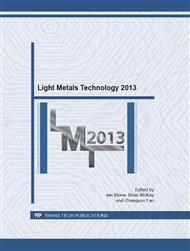p.368
p.373
p.378
p.383
p.388
p.393
p.398
p.403
p.408
Tailoring Microstructure and Mechanical Properties of 6063 Aluminium Alloy for Lightweight Structural Parts
Abstract:
In this work, an attempt has been made to improve the mechanical strength of 6063 aluminium alloy and thus its lightness via combination of severe plastic deformation (grain size refinement) and heat treatment (precipitation hardening). 6063 aluminium alloy was chosen as the best material for lightweight structures, where mass reduction is important, because of its high extrudability. Samples were hydrostatically extruded (HE) in supersaturated condition and subsequently subjected to an aging process. HE brings about significant grain size refinement well below 1 micron. The influence of aging parameters such as time and temperature on mechanical properties evolution of extruded material was determined. The microstructure of ultrafine grained (UFG) alloy was investigated using transmission electron microscopy. The average grain diameter and grain boundary misorientation angles (using Kikuchi lines) were measured. Mechanical properties were examined in microhardness and tensile tests. The results have shown that it is possible to combine grain boundary and precipitation strengthening and obtain ultrahigh strength in 6xxx series alloys. Additionally, heat treatment of UFG samples causes an increase in ductility measured in tensile tests, which is rather poor in severely deformed materials. To prove advantages of UFG aged samples for lightweight applications, finite element modelling was performed to compare the mass of chair elements made of coarse and ultrafine grained material. Simulations were made for the same stresses applied. It has been shown that if the chair was made of UFG aluminium alloy the mass reduction would be approximately 30 %.
Info:
Periodical:
Pages:
388-392
Citation:
Online since:
July 2013
Price:
Сopyright:
© 2013 Trans Tech Publications Ltd. All Rights Reserved
Share:
Citation:


